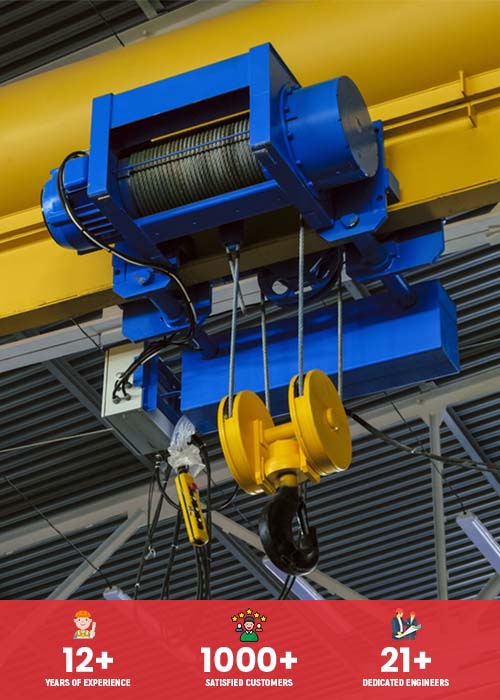Top Safety Precautions to Be Taken While Operating EOT or HOT Cranes
Cranes play a vital role in industries where heavy materials and equipment need to be lifted, shifted, or placed with precision. Among the most commonly used types are EOT (Electric Overhead Traveling) cranes and HOT (Hand Operated Traveling) cranes. Both are widely used in manufacturing units, warehouses, and construction sites for their ability to handle heavy loads efficiently. Typically, an EOT or HOT crane can support loads ranging from 125 kg to several tons. It is crucial to adopt the appropriate safety measures when handling such large loads in order to protect both the user and the load.
In this blog, we will discuss the top safety precautions to be taken while operating the crane systems.
Conduct Proper Training for Operators
The very first step toward crane safety is ensuring that only trained and certified personnel operate the equipment. Operators must have a thorough knowledge of crane functions, control systems, and emergency protocols. Training should cover:
- Load calculations and weight limitations
- Hand signals and communication methods
- Emergency shutdown procedures
- Regular inspection practices
Proper training minimizes the chances of human error, which is a leading cause of crane-related accidents.
Inspect the Crane Before Each Use
A detailed pre-operation inspection should be mandatory. Before starting work, operators must check the crane for signs of wear, damage, or malfunction. Some key points to inspect include:
- Brakes and control systems
- Wire ropes, hooks, and pulleys
- Power supply and switches
- Limit switches and safety latches
Even minor defects, if ignored, can lead to severe accidents. Regular inspection ensures that the crane is always in good working condition.
Never Exceed Load Capacity
Every crane is designed with a specific load capacity. Exceeding this limit is one of the most dangerous practices and can result in mechanical failure or structural collapse. Operators must:
- Check the weight of the load before lifting
- Use appropriate slings and lifting devices
- Avoid sudden jerks or swinging movements
Following the rated load limit helps maintain crane stability and prevents accidents.
Ensure Proper Load Balancing
Improperly balanced loads can tilt, slip, or swing uncontrollably, posing risks to both workers and property. To avoid such situations:
- Secure loads properly using hooks and clamps
- Distribute weight evenly
- Keep the load close to the ground while moving
Safe lifting requires not just strength but balance, and this is especially critical in overhead cranes.
Maintain a Clear Work Area
A cluttered workspace increases the risk of accidents during crane operations. Safety protocols should include:
- Marking and cordoning off the operating area
- Restricting entry of unauthorized personnel
- Keeping tools, materials, and debris away from the crane path
When the path is clear, the chances of collisions and accidents reduce significantly.
Follow Proper Communication Protocols
Communication plays a crucial role in crane operations, especially when multiple workers are involved. Operators should:
- Use standard hand signals when visibility is limited
- Employ communication devices like walkie-talkies in large facilities
- Always have a signalman when working in crowded areas
Clear communication ensures that everyone involved in the lifting operation is on the same page.
Avoid Side Pulling and Sudden Movements
EOT and HOT cranes are designed for vertical lifting. Attempting side pulls or making sudden directional changes puts immense stress on the crane components and can lead to failures. Operators should:
- Always lift loads vertically
- Move slowly and steadily
- Avoid unnecessary swinging of loads
Smooth operations not only enhance safety but also increase the life of the equipment.
Switch Off Power When Not in Use
After completing operations, it is essential to switch off the crane’s power supply. Leaving the power on increases the risk of accidental movements and electrical hazards. Additionally, parking the crane in a safe position and applying brakes ensures it does not move unintentionally.
Schedule Regular Maintenance
Apart from daily checks, cranes require professional servicing and maintenance at regular intervals. Preventive maintenance helps detect potential issues early and ensures compliance with safety regulations. Maintenance should be carried out by certified technicians and should include:
- Lubrication of moving parts
- Testing of control panels and circuits
- Replacement of worn-out parts
Keep Emergency Protocols Ready
Even with all precautions, emergencies can occur. Industries should have:
- Clearly marked emergency stop buttons
- First-aid kits and fire extinguishers nearby
- Evacuation plans and drills
Quick action during emergencies can save lives and minimize damage.
Conclusion
Operating cranes safely requires discipline, awareness, and a strong commitment to following protocols. Every crane system demands strict adherence to safety measures. Ultimately, the goal is not only to protect workers but also to maximize productivity and equipment lifespan. If you are looking to invest in a reliable crane system, it’s always wise to choose a trusted EOT crane manufacturer in India who prioritizes safety, quality, and durability in their products.




